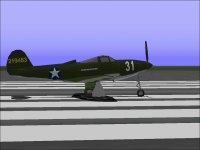aleatorylamp
Charter Member
A part = a text file!
Hello Ivan,
OK, slowly I´m getting to see how you make your useful little programs do things.
Your comment "The MoveIt program only works on a single Part. I just use it on
ALL the Parts in a directory if I intend to move the entire aeroplane." hinted that
the AFX or the SCASM Code are not the only places where the x,y,z vertex numbers
exist. I found them in the parts themselves! I didn´t know parts were text files too, but
they have to be for the AFA to process... How logical, and I hadn´t seen it.

That will make things much easier for a Qbasic program to work on a part, than
to open and search through the whole AFX for vertices - and then choke on them!
How interesting!
Thanks for your patience...
I´m glad your Texture mapping experiments with the Airacobra airplane-caricature

models are successful - textures faithfully adapt to all deformations!
Cheers,
Aleatorylamp
Hello Ivan,
OK, slowly I´m getting to see how you make your useful little programs do things.
Your comment "The MoveIt program only works on a single Part. I just use it on
ALL the Parts in a directory if I intend to move the entire aeroplane." hinted that
the AFX or the SCASM Code are not the only places where the x,y,z vertex numbers
exist. I found them in the parts themselves! I didn´t know parts were text files too, but
they have to be for the AFA to process... How logical, and I hadn´t seen it.

That will make things much easier for a Qbasic program to work on a part, than
to open and search through the whole AFX for vertices - and then choke on them!
How interesting!
Thanks for your patience...
I´m glad your Texture mapping experiments with the Airacobra airplane-caricature

models are successful - textures faithfully adapt to all deformations!
Cheers,
Aleatorylamp








